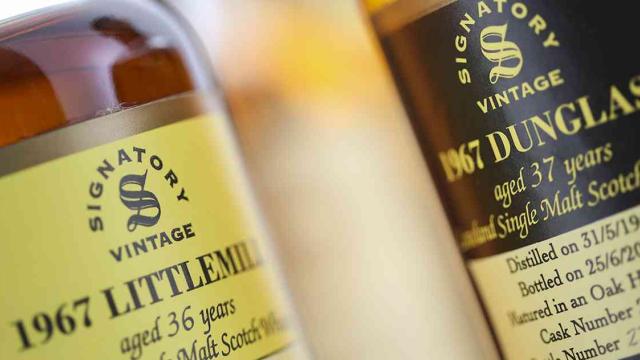Auction Highlights: Lost Lowlanders

The whisky-eyed traveller around Scotland can spot the melancholy facades of former distillery architecture. The sad pagodas and muted stone dunnages that are the remnants of distillates and flavours rapidly retiring into a solely bottled existence - or long since departed altogether. Unlike much of the rest of the country however, the Lowlands offers a whisky graveyard without physical form; only names, dates and curiosity keep the memory of some of Scotland’s most obscure departed single malts alive. That and a smattering of bottles of course.
For reasons of pragmatism and commercial necessity, the blenders of the 1950s and 60s decided to use the space and production capacity of monolithic lowland grain distilleries such as Moffat, Dumbarton and Garnheath, to create specific addition single malts with which to stoke up their blends. Often intended to be light, fruity, ‘Lowland-esque’ and versatile, these makes were there to bolster the warmth and heart of brands like Ballantine’s.
By quirk of the geek-fired enthusiasm for collecting and tasting Scottish single malts which would evolve over the following decades, these names have become some of the scarcest and most tricky whiskies to obtain or taste. These were names without visitor centres; they attracted little beyond passing profession curiosity during their lifetimes; their surrounding architecture was that of far larger distilleries; indeed, their main physical manifestation was often two pot stills or a single Lomond still.
These whiskies have also garnered something of a negative reputation over the years in terms of the actual quality of the liquid itself. Dismissed by blenders and industry professionals as dismal, bland or unremarkable. Indeed, the fact of their character and quality remains opaque and reliant on only a handful of bottlings in most cases. So a definitive assessment will likely remain impossible.
This is not always the case though. The few bottled examples of Killyloch - which was reputedly a ‘lightly peated’ make produced at Moffat Distillery from around 1965 until the early 1970s - reveal a pleasingly elegant, fruity and rather juicy single malt. If there was ever any peat I’ve never detected it in the examples I’ve tasted. I particularly enjoyed the Signatory 1972 22 year old cask #206413, there’s a level of spice and body which carries the fruits over very well in this one.
Signatory also bottled some sibling casks from the same vintage of Glen Flagler. Also produced at Moffat Distillery between 1965 and 1985, this is a slightly more common name in some respects as it was even bottled as a single malt in its own official livery in the 1970s and early 1980s. However, independent examples remain scarce. Also a lowland style make, it is perhaps the best of the bunch with its more exuberant and cheeky fruitiness that lends a more pronounced sense of personality to the bottlings I’ve tasted. Once again, the Signatory 1972s are my favourites.
There are other names which are even rarer. Lomond: which exists only in a pair of bottlings by the Scotch Malt Whisky Society. Islebrae: a reportedly heavily peated sibling to Killyloch, not a drop of which appears to have survived or been bottled. Then there are other, perhaps more ‘unlikely’ names such as Dunglass. Unlike the others Dunglass was a peated malt produced in the late 1960s within Littlemill Distillery. Unlike some of the other obscure names from this era, Dunglass probably deserves its reputation with soapiness often reported as a cornerstone flavour. However, the one to get is the 1967 37 year old bottling by Signatory. It’s in a 50cl bottle and I’ve never tasted it, but it comes with a twin bottling of 1967 Littlemill which should make for a truly fascinating head to head if you ever get the chance.
While focus these days rests, understandably, with the more alluring and celebrated lost names of the highlands and islands, it is worth sparing some attention for these mysterious and elusive lowlanders. They represent fascinating and curious cul-de-sacs of whisky history and (most of the time) are actually pleasing and intellectually fascinating things to taste as well.




